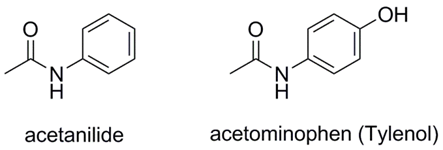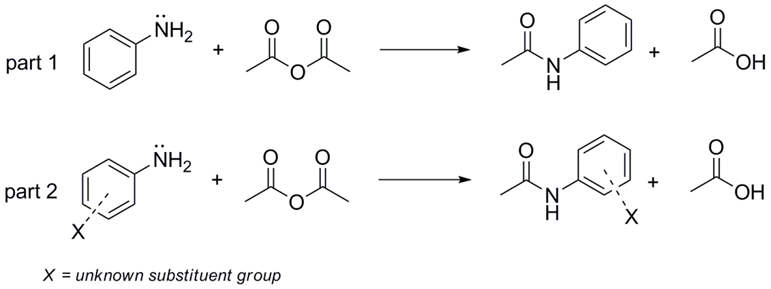Chapter 1.
Background
Acetanilide is an analgesic and was formally known as Antifebrin1, and is structurally similar to acetaminophen (or Tylenol). However, unlike acetaminophen, acetanilide is toxic. Acetanilide is prepared from aniline using an acetylation reaction. Acetylation is often used to place an acetyl protecting group on primary or secondary amines to reduce their reactivity toward oxidizing agents or electrophiles. Acetamides are usually crystalline solids which can be a help in purification by recrystallization. The melting points can be used for characterization and identification of the corresponding compounds.

Reaction
Acetylation of aniline and unknown substituted anilines with acetic anhydride


Lab Objective
In part 1 you will convert aniline to acetanilide using an acetylation reaction described below.
In part 2 you will be given an unknown aromatic amine from table 1-1 below. The amine will be converted into its acetamide analog also using the acetylation procedure described below. Your objective is to compare the two reactions and determine the identity of the unknown amine/acetamide product.
Procedure
Reagents:
- Aniline
- HCl (concentrated HCl is 37% w/w)
- Acetic anhydride
- Sodium acetate
Part 1:
Dissolve 500 mg of aniline in 14 mL of water. Note that aniline is immiscible in water and two layers should be observed. Add 0.45 mL of concentrated hydrochloric acid and stir. Measure out 0.6 mL of acetic anhydride and prepare a solution of 530 mg of sodium acetate in 3 mL of water. Add the acetic anhydride to the solution of aniline hydrochloride in water, mix by swirling, and immediately add the sodium acetate solution. The solution becomes white as acetanilide precipitates. Cool the solution in an ice bath and collect the solid acetanilide by vacuum filtration. Recrystallize from ethanol 95% - it may be necessary to add a small amount of water.
Part 2:
Use the above procedure for acetylation of the substituted unknown aniline. Exact quantities cannot be calculated since the starting material is an unknown.
Techniques
- Beilstein test
- Melting point
- Recrystallization
- Gravity & vacuum filtration
- Thin layer chromatography
- Infrared spectroscopy.
Characterization
Both products of part 1 and 2 should be co-spotted against the starting material for each reaction, respectively, and against each other. Collect the Infrared spectrum of the part 1 product, acetanilide, and the unknown starting material and product from part 2. Characterize the products of part 1 and 2 by m.p and using the Beilstein test for halogens.
For the Beilstein test first clean a copper wire by holding it briefly in a flame. Touch the wire to a sample of the compound and return it to the flame. A blue-green color in the flame indicates the presence of a halogen. It is a good idea to test the procedure on a compound known to contain a halogen before trying it on your own compound.
bp & mp
| Amine | bp (°C) | mp (°C) | Acetamide mp (°C) |
|---|---|---|---|
| aniline | 184 | 114 | |
| N-methylaniline | 196 | 102 | |
| ortho-toluidine | 200 | 110 | |
| meta-toluidine | 203 | 65 | |
| 2-chloroaniline | 209 | 87 | |
| 2-ethylaniline | 210 | 111 | |
| 2,5-dimethylaniline | 213 | 14 | 139 |
| 2,6-dimethylaniline | 215 | 11 | 177 |
| 4-ethylaniline | 216 | –6 | 94 |
| 2,4-dimethylaniline | 217 | 133 | |
| 3,5-dimethylaniline | 220 | 10 | 144 |
| 2,3-dimethylaniline | 221 | 4 | 135 |
| 3-chloroaniline | 230 | 72, 78 | |
| meta-anisidine | 251 | 81 | |
| para-toluidine | 200 | 44 | 147, 153 |
| 3,4-dimethylaniline | 224 | 49 | 99 |
| 2,5-dichloroaniline | 251 | 50 | 132 |
| para-anisidine | 240 | 58 | 127 |
| para-bromoaniline | 245 | 66 | 168 |
| para-chloroaniline | 232 | 72 | 172, 179 |